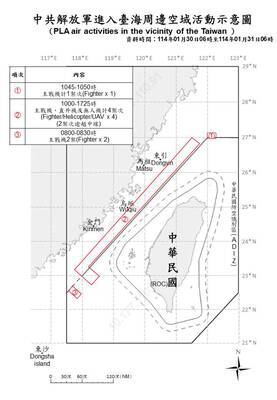Japanese Prime Minister Fumio Kishida yesterday canceled plans to visit Central Asia and Mongolia this weekend, following an unprecedented advisory that the risk of a major Pacific coast earthquake was higher than usual.
The Japan Meteorological Agency on Thursday issued its first-ever advisory of the risk of a huge earthquake on the nation’s Pacific coast, following a magnitude 7.1 tremor that struck the southwestern island of Kyushu the same day.
“I have decided to stay in the country for the next week or so to ensure our preparations and communications are in order,” Kishida told a press conference, although the advisory did not give a timeframe for the potential event or call for evacuations.

Photo: AFP
“But it is the first time it is issued and I believe people would be feeling anxious about it,” he said.
“Consequently, I have decided to cancel my planned visit to Central Asia and Mongolia,” he said.
The government might hold the meetings with regional leaders online instead, public broadcaster NHK said.
The visit to Kazakhstan, Uzbekistan and Mongolia was originally set to run from yesterday to Monday.
The meteorological agency warned of a higher probability of a huge earthquake in the Nankai trough, an ocean-floor trench running along Japan’s Pacific coast where previous quakes have triggered enormous tsunamis.
It did not indicate a quake would happen, but encouraged people to be ready to evacuate if necessary.
Normally, Japan estimates the probability of an earthquake of magnitude 8 or 9 happening around the trough in the next 30 years at 70 to 80 percent, which equates to a one-in-a-thousand chance of an earthquake there in any given week.
With the new advisory, that probability has risen to a one-in-several-hundred chance, the agency said.
Some supermarkets in Shizuoka are reporting supply shortages after customers snapped up bottled water and reheatable rice packs, NHK said.
The current alert system came into effect in 2019, as the government sought to establish a way to put the public on alert for potential earthquakes, despite the difficulty of predicting when one might strike.

UNITED: The premier said Trump’s tariff comments provided a great opportunity for the private and public sectors to come together to maintain the nation’s chip advantage The government is considering ways to assist the nation’s semiconductor industry or hosting collaborative projects with the private sector after US President Donald Trump threatened to impose a 100 percent tariff on chips exported to the US, Premier Cho Jung-tai (卓榮泰) said yesterday. Trump on Monday told Republican members of the US Congress about plans to impose sweeping tariffs on semiconductors, steel, aluminum, copper and pharmaceuticals “in the very near future.” “It’s time for the United States to return to the system that made us richer and more powerful than ever before,” Trump said at the Republican Issues Conference in Miami, Florida. “They

GOLDEN OPPORTUNITY: Taiwan must capitalize on the shock waves DeepSeek has sent through US markets to show it is a tech partner of Washington, a researcher said China’s reported breakthrough in artificial intelligence (AI) would prompt the US to seek a stronger alliance with Taiwan and Japan to secure its technological superiority, a Taiwanese researcher said yesterday. The launch of low-cost AI model DeepSeek (深度求索) on Monday sent US tech stocks tumbling, with chipmaker Nvidia Corp losing 16 percent of its value and the NASDAQ falling 612.46 points, or 3.07 percent, to close at 19,341.84 points. On the same day, the Philadelphia Stock Exchange Semiconductor Sector index dropped 488.7 points, or 9.15 percent, to close at 4,853.24 points. The launch of the Chinese chatbot proves that a competitor can

TAIWAN DEFENSE: The initiative would involve integrating various systems in a fast-paced manner through the use of common software to obstruct a Chinese invasion The first tranche of the US Navy’s “Replicator” initiative aimed at obstructing a Chinese invasion of Taiwan would be ready by August, a US Naval Institute (USNI) News report on Tuesday said. The initiative is part of a larger defense strategy for Taiwan, and would involve launching thousands of uncrewed submarines, surface vessels and aerial vehicles around Taiwan to buy the nation and its partners time to assemble a response. The plan was first made public by the Washington Post in June last year, when it cited comments by US Indo-Pacific Commander Admiral Samuel Paparo on the sidelines of the Shangri-La Dialogue

MARITIME SECURITY: Of the 52 vessels, 15 were rated a ‘threat’ for various reasons, including the amount of time they spent loitering near subsea cables, the CGA said Taiwan has identified 52 “suspicious” Chinese-owned ships flying flags of convenience that require close monitoring if detected near the nation, the Coast Guard Administration (CGA) said yesterday, as the nation seeks to protect its subsea telecoms cables. The stricter regime comes after a Cameroon-flagged vessel was briefly detained by the CGA earlier this month on suspicion of damaging an international cable northeast of Taiwan. The vessel is owned by a Hong Kong-registered company with a Chinese address given for its only listed director, the CGA said previously. Taiwan fears China could sever its communication links as part of an attempt